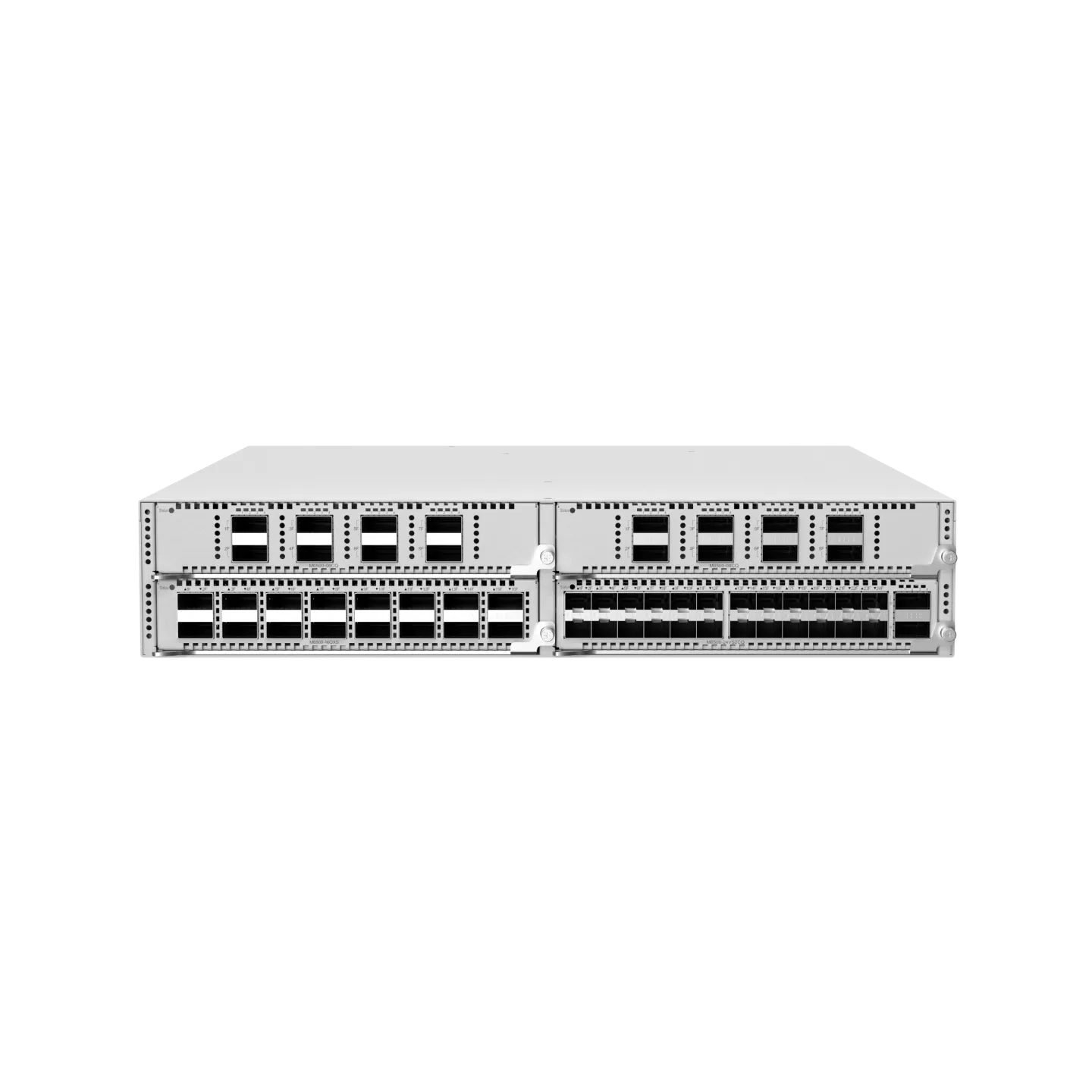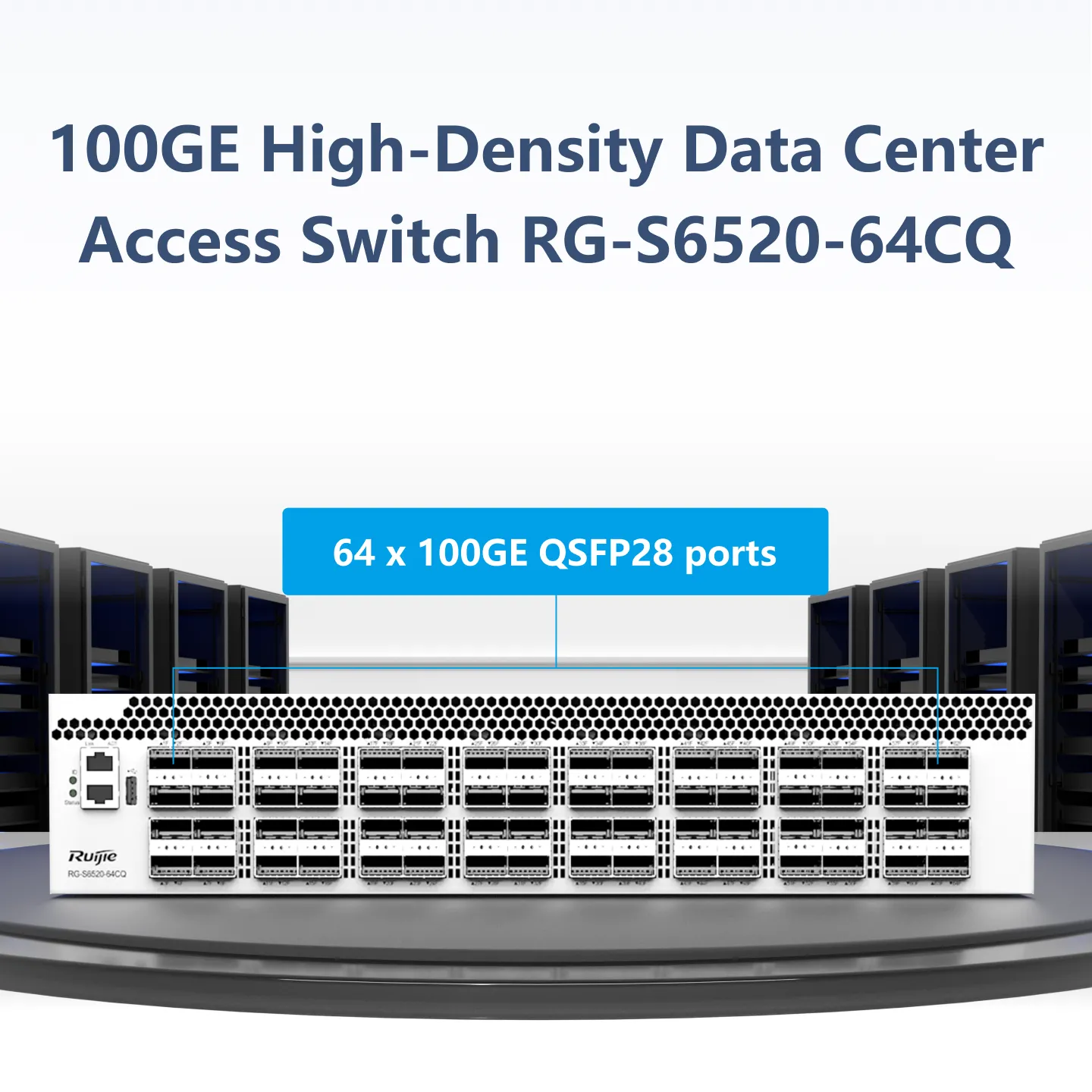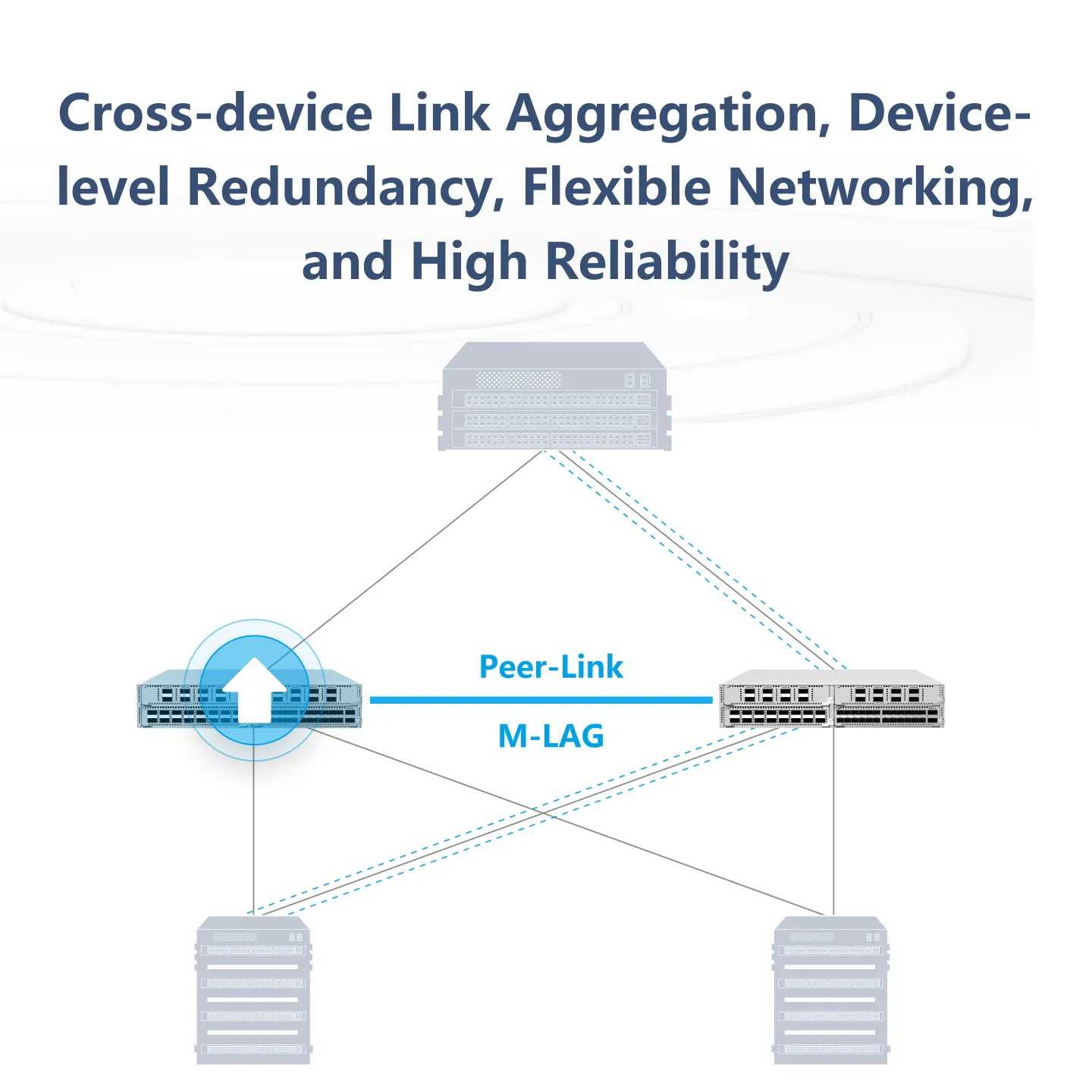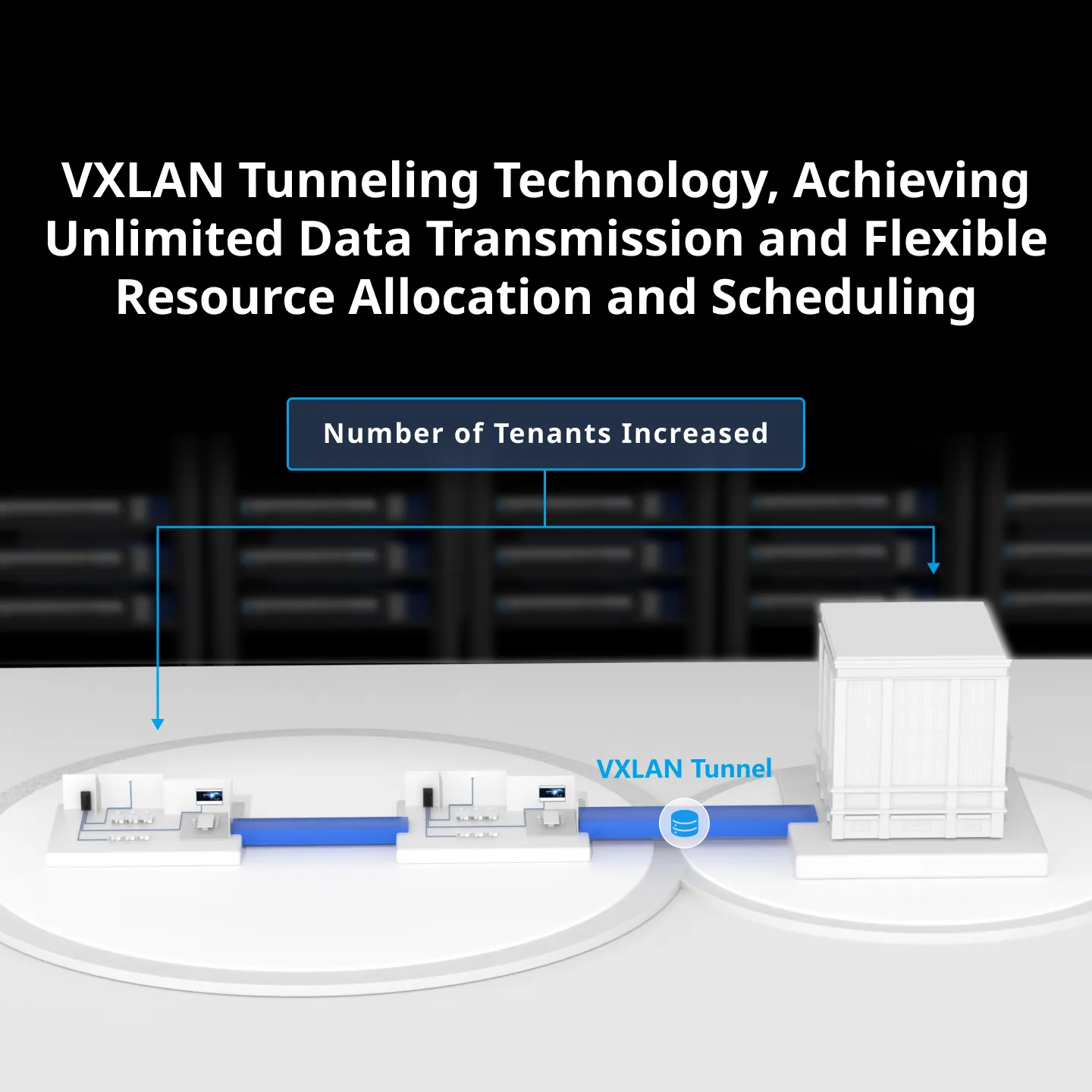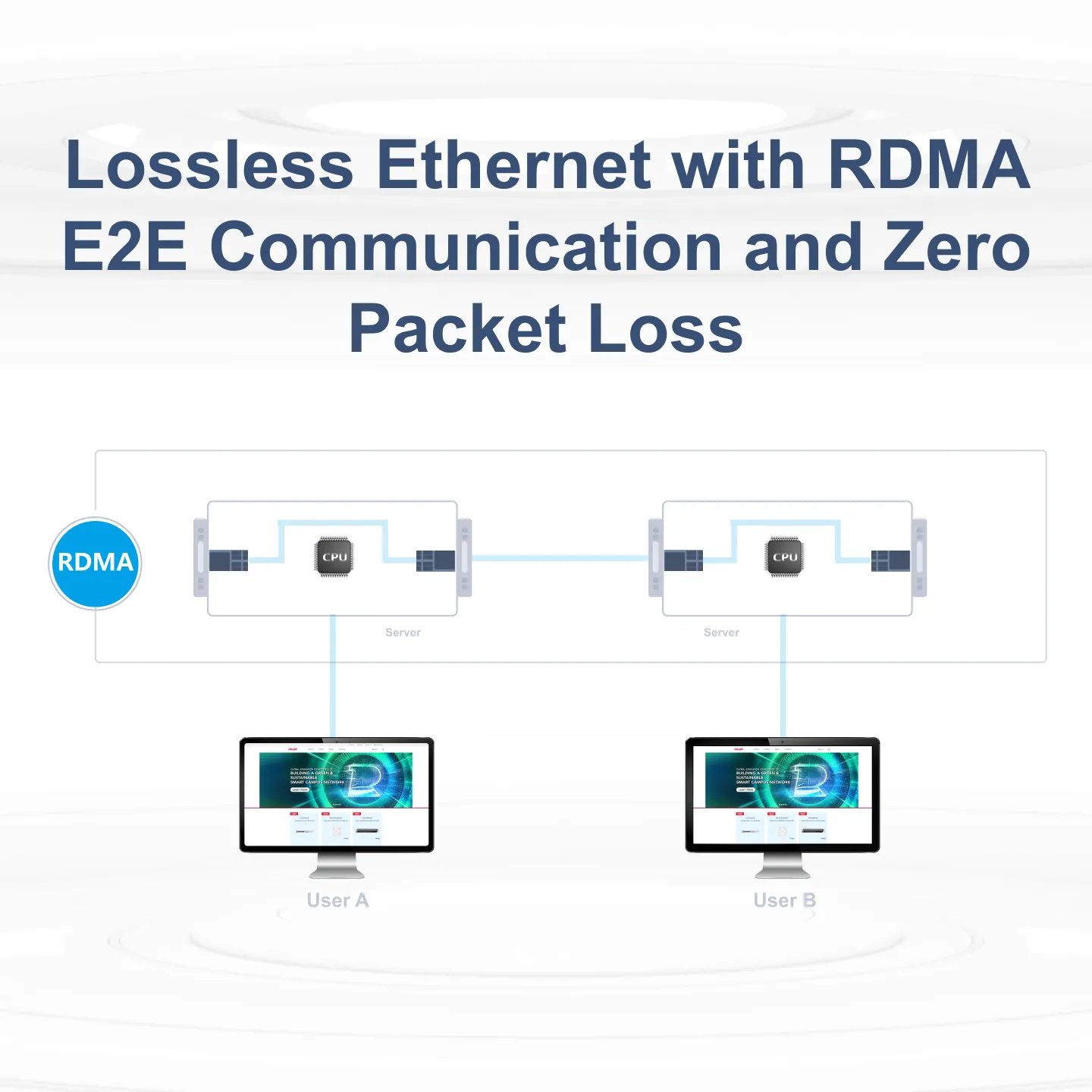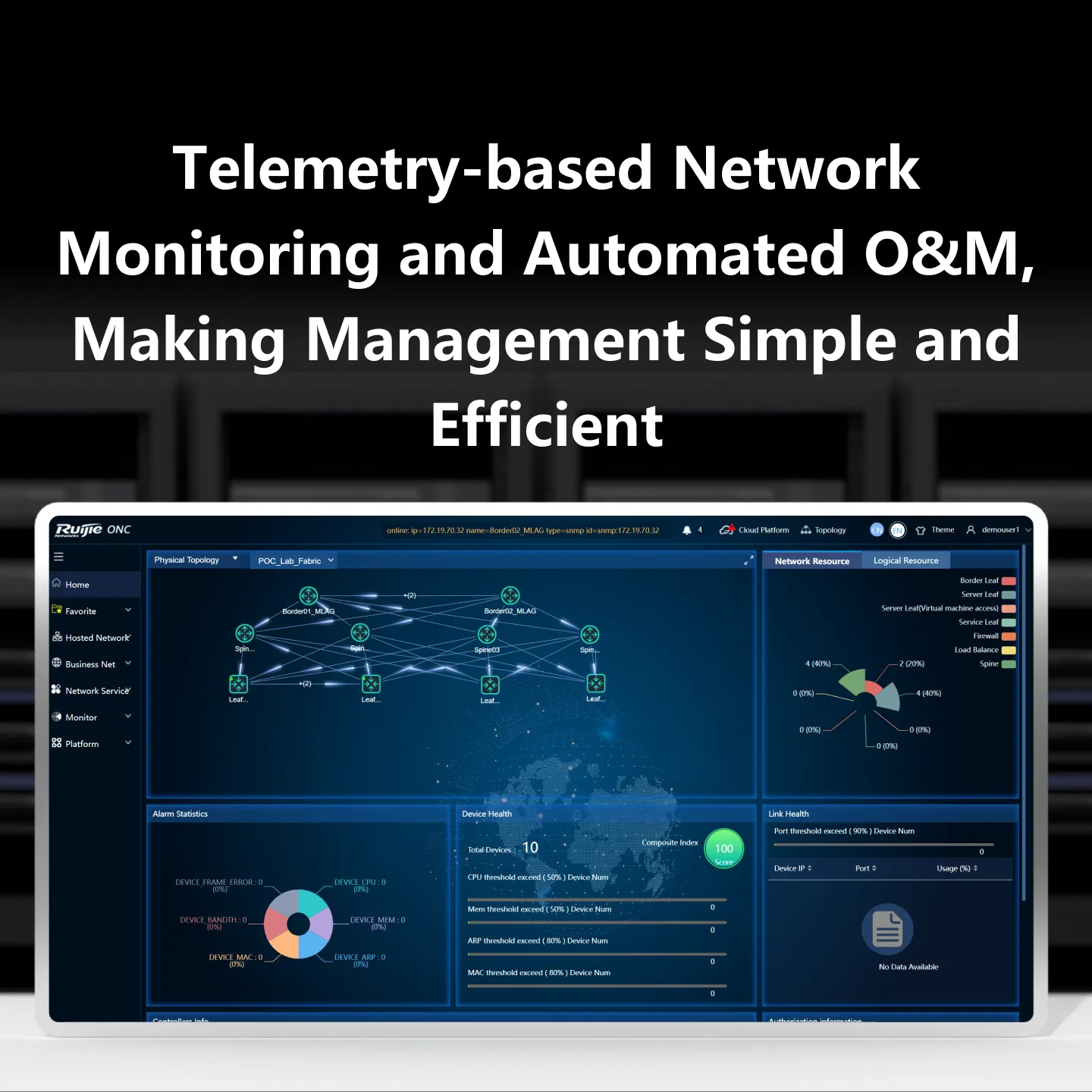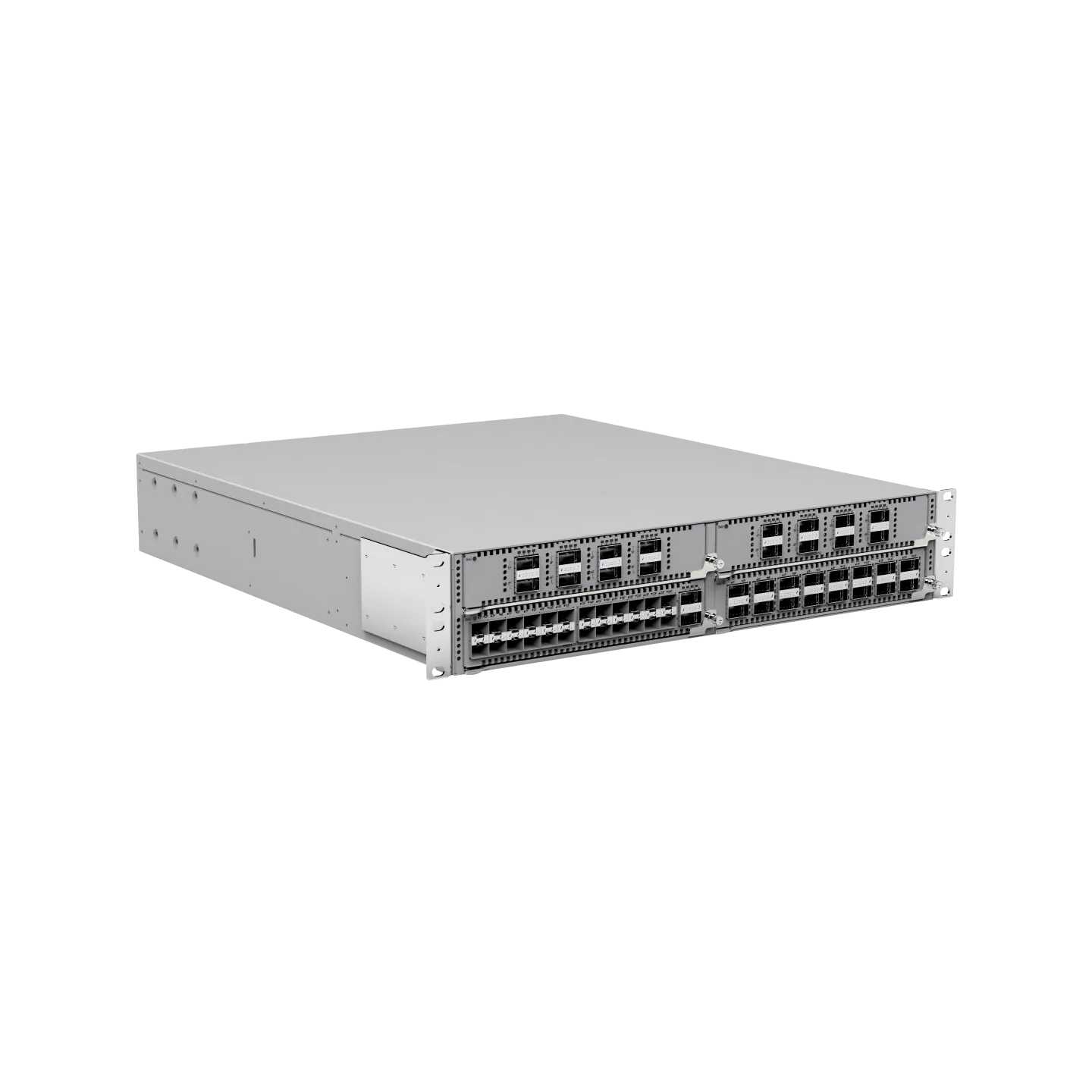RG-S6510-4C 100GE Data Center Access Switch
M-LAG/VSU/de-stacking for higher availability, PFC/ECN-based lossless RDMA network with high performance
four service slots, 25GE/40GE/100GE line cards
RG-S6510-32CQ32×100G ports
RG-S6510-48VS8CQNumber of IPv4/IPv6 host routing entries: 128K/64K
- 96 x 25GE ports and 8 x 100GE ports, 32 x 100GE ports, or 64 x 40GE ports housed in a 2 RU enclosure for flexible networking
- Cross-device link aggregation (De-stacking/M-LAG/VSU), device-level redundancy, flexible networking, and high reliability
- VXLAN tunneling technology, achieving unlimited data transmission and flexible resource allocation and scheduling
- Lossless Ethernet, ensuring zero packet loss during RDMA E2E communication
- Telemetry/gRPC/sFlow/SPAN-based network monitoring and automated O&M, making management simple and efficient
- Key Specification
- Features
- Specifications
- Resources
- Order Information
Hardware Specifications
| System Specifications |
RG-S6510-4C |
| Ports |
25GE, 40GE, and 100GE ports |
| Slots |
4 |
| Expansion Modules |
M6500-24VS2CQ, M6500-08CQ, M6500-16QXS |
| Expansion Module Slots |
Power supply module slots Fan module slots |
| Management Port |
One management port, one console port, and one USB port, compliant with the USB2.0 standard |
| Switching Capacity |
6.4 Tbps |
| Packet Forwarding Rate |
2030 Mpps |
| 802.1Q VLAN |
4094 |
| Dimensions and Weight |
RG-S6510-4C |
| Dimensions |
442 mm x 520 mm x 86 mm (17.40 in. x 20.47 in. x 3.39 in., 2 RU) |
| Weight |
About 14 kg (30.86 lbs., including power supply modules and fan modules) |
| Power Supply and Consumption |
RG-S6510-4C |
| AC |
Rated voltage: 110 V/220 V Rated voltage range: 100 V AC to 240 V AC, 50 Hz to 60 Hz Maximum voltage range: 90 V AC to 264 V AC, 47 Hz to 63 Hz Rated input current: 5 A to 10 A |
| High-voltage DC |
RG-PA800I-F module ● HVDC voltage range: 180 V DC to 310 V DC ● Rated voltage: 240 V DC ● Max input current: 5 A RG-PD800I-F module ● Rated voltage range: –36 V DC to –72 V DC ● Rated voltage: –48V DC ● Max input current: 23 A |
| Maximum Power Consumption |
● Max: 650 W ● Typical: 455 W ● Static: 202 W |
| Environment and Reliability |
RG-S6510-4C |
| Operating Temperature |
0ºC to 40ºC (32ºF to 104ºF) |
| Storage temperature |
-40 °C to 70 °C (-40 °F to 158 °F) |
| Operating Humidity |
10% RH to 90% RH (Non-condensing) |
| Storage humidity |
5% to 95% RH (non-condensing) |
| Working altitude |
Operating altitude: up to 5000 m (16,404.20 ft.) Storage altitude: up to 5000 m (16,404.20 ft.) |
Software Specifications
| Software Specifications |
RG-S6510-4C |
| Device virtualization |
Virtual Switching Unit 3.0 |
| L2 Protocols |
IEEE802.3ad (Link Aggregation Control Protocol), IEEE802.1p, IEEE802.1Q, IEEE802.1D (STP), IEEE802.1w (RSTP), IEEE802.1s (MSTP), IGMP Snooping, MLD Snooping, Jumbo Frame (9 KB), IEEE802.1ad (QinQ and selective QinQ), GVRP |
| L3 Protocols (IPv4) |
BGP4, OSPFv2, RIPv1, RIPv2, MBGP, LPM Routing, Policy-based Routing (PBR), Route-policy, Equal-Cost Multi-Path Routing (ECMP), WCMP, VRRP, IGMP v1/v2/v3, PIM-SSM/SM/DM, MSDP, Any-RP |
| IPv6 Basic Protocols |
Neighbor Discovery, ICMPv6, Path MTU Discovery, DNSv6, DHCPv6, ICMPv6, ICMPv6 redirection, ACLv6, TCP/UDP for IPv6, SNMP v6, Ping/Traceroute v6, IPv6 RADIUS, Telnet/SSH v6, FTP/TFTP v6, NTP v6, IPv6 MIB support for SNMP, VRRP for IPv6, IPv6 QoS |
| IPv6 Features |
Static routing, ECMP, PBR, OSPFv3, RIPng, BGP4+, MLDv1/v2, PIM-SMv6, manual tunnel, automatic tunnel, IPv4 over IPv6 tunnel, and ISATAP tunnel |
| Data Center Features |
VXLAN routing and VXLAN bridging EVPN VXLAN IPv6 VXLAN over IPv4 PFC, ECN, and other data center features RDMA M-LAG OpenFlow 1.3 |
| Visualization |
gRPC sFLOW sampling INT |
| ACL |
Standard IP-based ACL、Extended MAC-based ACL、Extended IP-bsaed ACL、Expert-level ACL、ACL 80、IPv6 ACL、ACL Logging、Ingress/Egress ACLs、ACL Counter (Ingress and egress counters are supported in interface or global configuration modes)、ACL Re-marking、Global ACL、ACL-based Redirection、Displaying ACL Resources、Processing First Packet of TCP Handshake When Binding the ACL to Restrict SIP、Matching Against 5-Tuple of Pass-by VXLAN Inner IP Packets、The expert-level ACL supports matching the IP flag and DSCP fields of VXLAN inner packets |
| QoS |
Mapping of IEEE 802.1p, DSCP, and ToS priorities |
| Virtualization |
Virtual Switching Unit |
| Buffer Management |
Buffer status monitoring and management, and identification of burst traffic |
| HA Design |
GR for RIP/OSPF/BGP, BFD, REUP dual-link fast switching and RLDP unidirectional link detection, 1+1 power redundancy, and fan redundancy, and hot swapping for all cards and power supply modules |
| Security Features |
Network Foundation Protection Policy (NFPP), CPP, DDoS attack defense, illegitimate data packet detection, data encryption, source IP spoofing prevention, IP scanning prevention, RADIUS/TACACS, IPv4/v6 packet filtering by basic ACL, extended ACL or VLAN-based ACL, plaintext-based and MD5 ciphertext-based authentication for OSPF, RIPv2, and BGPv4 packets, telnet login and password mechanisms for restricted IP addresses, uRPF, broadcast packet suppression, DHCP Snooping, gateway ARP spoofing prevention, and ARP check |
| Management Mode |
SNMP v1/v2c/v3, Netconf, telnet, console, MGMT, RMON, SSHv1/v2, FTP/TFTP, NTP clock, Syslog, SPAN/RSPAN, Telemetry, ZTP, Python, fan and power supply alarm, and temperature alarm |
| Other Protocols |
DHCP Client, DHCP Relay, DHCP Server, DNS Client, UDP relay, ARP Proxy, and Syslog |
Safety and Regulatory Compliance
| Specification |
RG-S6510-4C |
| Safety |
● NM EN 62368-1 ● NM CEI62368-1 ● IEC 62368-1 ● EN 62368-1 ● BS EN 62368-1 ● UL 62368-1 ● CSA C22.2#62368-1 ● GB 4943.1 |
| Electromagnetic Compatibility (EMC) |
● EN 61000-4-2 ● EN 61000-4-3 ● EN 61000-4-4 ● EN 61000-4-5 ● EN 61000-4-6 ● EN 61000-4-11 ● EN 55032 ● EN 55035 ● EN 61000-3-2 ● EN 61000-3-3 ● EN IEC 61000-3-2 ● EN IEC 61000-3-3 ● EN 300 386 ● ETSI EN 300 386 ● NM EN 55035 ● NM EN 61000-3-2 ● NM EN 61000-3-3 ● BS EN 55032 ● BS EN 55035 ● BS EN 61000-3-2 ● BS EN 61000-3-3 ● CNS 13438 ● FCC CFR Title 47, Part 15, Subpart B ● ANSI C63.4-2014 ● ICES-003 Issue 7 ● GB/T 9254.1 |
| Environment |
● 2011/65/EU EN 50581 ● 2012/19/EU EN 50419 ● (EC) No.1907/2006 ● GB/T 26572 |
*For more country-specific regulatory information and approvals, contact your local sales agency.
The configuration procedure for RG-S6510-4C series switches is as follows:
- Select the switch, fan, and power supply modules.
- Select expansionmodules based on port
- Select optical transceivers.
Chassis, Fan, and Power Supply ModulesProduct Model
Description
RG-S6510-4C
Four expansion module slots, supporting hot swapping.
Two power supply module slots and three fan module slots
The power supply model is RG-PA800I-F, and the fan model is M6500-FAN-F.RG-PA800I-F
Power supply module, supporting 1+1 redundancy, hot swapping, and front-to-rear ventilation design
M6500-FAN-F
Fan module, supporting 2+1 redundancy, hot swapping, and front-to-rear ventilation design
Expansion Modules
Product Model
Description
M6500-08CQ
Eight QSFP28 ports
The QSFP28 port supports a speed of 40 Gbps/100 Gbps.
M6500-24VS2CQ
24 25GE SFP28 ports and two QSFP28 ports
SFP28 supports a speed of 10G/25G rates.
The QSFP28 port supports a speed of 40 Gbps/100 Gbps. One QSFP port can be split into four 10GE or 25GE ports.
M6500-16QXS
16 QSFP ports
The QSFP28 port supports a speed of 40 Gbps.100GBASE Series Optical Modules
Product Model
Description
100G-QSFP-SR-MM850
100G SR module, QSFP28 form factor, MPO, 850 nm, 100 m (328.08 ft.) over MMF
100G-QSFP-LR4-SM1310
100G LR4 module, QSFP28 form factor, Duplex LC, 1310 nm, 10 km (32,808.40 ft.) over SMF
100G-QSFP-iLR4-SM1310
100G iLR4 module, QSFP28 form factor, Duplex LC, 1310 nm, 2 km (6,561.68 ft.) over SMF
100G-QSFP-ER4-SM1310
100G ER4 module, QSFP28 form factor, Duplex LC, 1310 nm, 40 km (131,233.59 ft.) over SMF
100G-AOC-5M
100G QSFP28 AOC cable, 5 m (16.40 ft.)
100G-AOC-10M
100G QSFP28 AOC cable, 10 m (32.81 ft.)
40GBASE Series Optical Modules
Product Model
Description
40G-QSFP-SR-MM850
40G SR module, QSFP+ form factor, MPO, 150 m (492.13 ft.) over MMF
40G-QSFP-LR4-SM1310
40G LR4 module, QSFP+ form factor, Duplex LC, 10 km (32,808.40 ft.) over SMF
40G-QSFP-LSR-MM850
40G LSR module, QSFP+ form factor, MPO, 400 m (1,312.34 ft.) over MMF
40G-QSFP-iLR4-SM1310
40G iLR4 module, QSFP+ form factor, Duplex LC, 2 km (6,561.68 ft.) over SMF
40G-QSFP-LX4-SM1310
40G LX4 module, QSFP+ form factor, Duplex LC connector, 150 m (492.13 ft.) over OM3/OM4 MMF, or 2 km (6,561.68 ft.) over SMF
40G-AOC-30M
40G QSFP+ AOC cable, 30 m (98.43 ft.)
40G-AOC-5M
40G QSFP+ AOC cable, 5 m (16.40 ft.)
25GBASE Series Optical Modules
Product Model
Description
VG-SFP-LR-SM1310
25G LR module, SFP28 form factor, Duplex LC, 1310 nm, 10 km (32,808.40 ft.) over SMF
VG-SFP-AOC5M
25G SFP28 AOC cable, 5 m (16.40 ft.)
10GBASE Series Optical Modules
Product Model
Description
XG-LR-SM1310
10G LR module, SFP+ form factor, Duplex LC, 10 km ((32,808.40 ft.) over SMF
XG-SFP-ER-SM1550
10G ER module, SFP+ form factor, Duplex LC, 40 km (131,233.60 ft.) over SMF
XG-SFP-LR-SM1310
10G LR module, SFP+ form factor, Duplex LC, 10 km ((32,808.40 ft.) over SMF
XG-SFP-SR-MM850
10G SR module, SFP+ form factor, Duplex LC, 300 m (984.25 ft.) over MMF
XG-SFP-ZR-SM1550
10G ZR module, SFP+ form factor, Duplex LC, 80 km (262,467.19 ft.) over SMF
XG-SR-MM850
10G SR module, SFP+ form factor, Duplex LC, 300 m (984.25 ft.) over MMF
XG-SFP-AOC1M
10G SFP+ AOC cable, 1 m (3.28 ft.)
XG-SFP-AOC3M
10G SFP+ AOC cable, 3 m (9.84 ft.)
XG-SFP-AOC5M
10G SFP+ AOC cable, 5 m (16.40 ft.)
1000BASE Series Optical Modules
Product Model
Description
GE-SFP-LH40-SM1310-BIDI
1G LH module, SFP form factor, BIDI LC, 40 km (131,233.60 ft.) over SMF
GE-SFP-LX20-SM1310-BIDI
1G LX module, SFP form factor, BIDI LC, 20 km (65,616.80 ft.) over SMF
GE-SFP-LX20-SM1550-BIDI
1G LX module, SFP form factor, BIDI LC, 20 km (65,616.80 ft.) over SMF
MINI-GBIC-LH40-SM1310
1G LH module, SFP form factor, Duplex LC, 40 km (131,233.60 ft.) over SMF
MINI-GBIC-LX-SM1310
1G LX module, SFP form factor, Duplex LC, 10 km (32,808.40 ft.) over SMF
MINI-GBIC-SX-MM850
1G SR module, SFP form factor, Duplex LC, 550 m (1,804.46 ft.) over MMF
MINI-GBIC-ZX80-SM1550
1G ZX module, SFP form factor, Duplex LC, 80 km (262,467.19 ft.) over SMF
1000BASE Series Electrical Modules
Product Model
Description
Mini-GBIC-GT(F)
1G SFP copper module, SFP form factor, RJ45, 100 m (328.08 ft.) over Cat 5e/6/6a
Mini-GBIC-GT
1G SFP copper module, SFP form factor, RJ45, 100 m (328.08 ft.) over Cat 5e/6/6a
